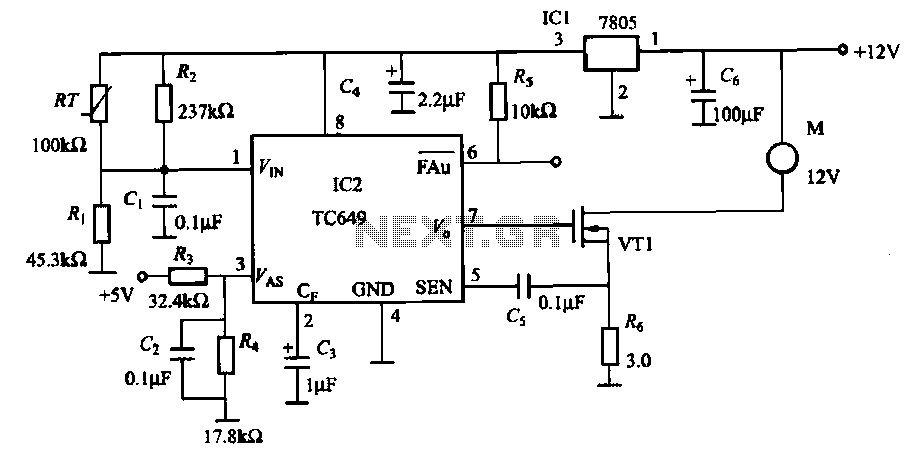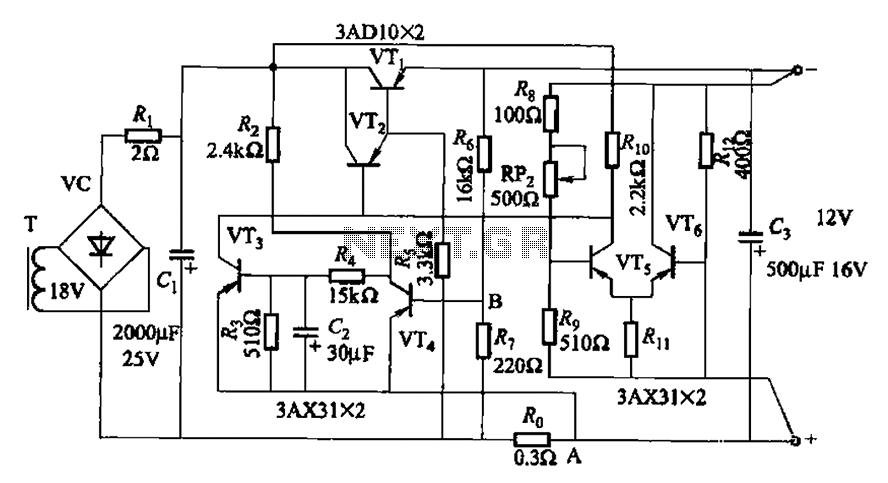
W723 High-Voltage Current-Limiting Protection

The application circuit depicted below features an output voltage that exceeds the referenced voltage. It utilizes the W723 multi-port adjustable positive voltage regulator, which incorporates current limiting protection. The output voltage can be adjusted within a range of 7V to 36V. The input voltage illustrated is 20V, resulting in an output voltage of 15V.
The W723 multi-port adjustable positive voltage regulator is designed to provide a stable output voltage while allowing for flexibility in adjusting the voltage level according to specific application requirements. This regulator is particularly useful in scenarios where varying output voltages are needed without the necessity for multiple fixed voltage regulators.
The current limiting protection feature integrated into the circuit ensures that the output current does not exceed a predetermined threshold, thereby safeguarding both the regulator and the connected load from potential damage due to overcurrent conditions. This is crucial in applications where load characteristics may fluctuate, as it helps maintain the integrity of the circuit.
The adjustable output voltage range from 7V to 36V allows the W723 to be utilized in a variety of applications, such as powering sensors, microcontrollers, and other electronic devices that require different operating voltages. The specific configuration shown, with an input voltage of 20V and an output voltage of 15V, demonstrates the regulator's capability to efficiently step down the input voltage while maintaining a stable output.
In designing the circuit, attention should be given to the selection of appropriate input and output capacitors, as these components play a vital role in ensuring stability and transient response. Additionally, the layout of the circuit board should minimize the length of traces between the regulator and the load to reduce the effects of parasitic inductance and resistance.
Overall, the W723 multi-port adjustable positive voltage regulator circuit is a versatile and reliable solution for applications requiring adjustable voltage levels, with built-in protections to enhance circuit longevity and performance.The application circuit shown in the picture below with output voltage higher thanreferenced voltage is composed of the W723 multi-port adjustable positive stabilizer. There is current limiting protectionin this circuit and the output voltage is adjustable from 7V to 36V.
The input voltage in the picture is 20V, and its output voltage is 15V. The circuit in.. 🔗 External reference
The W723 multi-port adjustable positive voltage regulator is designed to provide a stable output voltage while allowing for flexibility in adjusting the voltage level according to specific application requirements. This regulator is particularly useful in scenarios where varying output voltages are needed without the necessity for multiple fixed voltage regulators.
The current limiting protection feature integrated into the circuit ensures that the output current does not exceed a predetermined threshold, thereby safeguarding both the regulator and the connected load from potential damage due to overcurrent conditions. This is crucial in applications where load characteristics may fluctuate, as it helps maintain the integrity of the circuit.
The adjustable output voltage range from 7V to 36V allows the W723 to be utilized in a variety of applications, such as powering sensors, microcontrollers, and other electronic devices that require different operating voltages. The specific configuration shown, with an input voltage of 20V and an output voltage of 15V, demonstrates the regulator's capability to efficiently step down the input voltage while maintaining a stable output.
In designing the circuit, attention should be given to the selection of appropriate input and output capacitors, as these components play a vital role in ensuring stability and transient response. Additionally, the layout of the circuit board should minimize the length of traces between the regulator and the load to reduce the effects of parasitic inductance and resistance.
Overall, the W723 multi-port adjustable positive voltage regulator circuit is a versatile and reliable solution for applications requiring adjustable voltage levels, with built-in protections to enhance circuit longevity and performance.The application circuit shown in the picture below with output voltage higher thanreferenced voltage is composed of the W723 multi-port adjustable positive stabilizer. There is current limiting protectionin this circuit and the output voltage is adjustable from 7V to 36V.
The input voltage in the picture is 20V, and its output voltage is 15V. The circuit in.. 🔗 External reference





